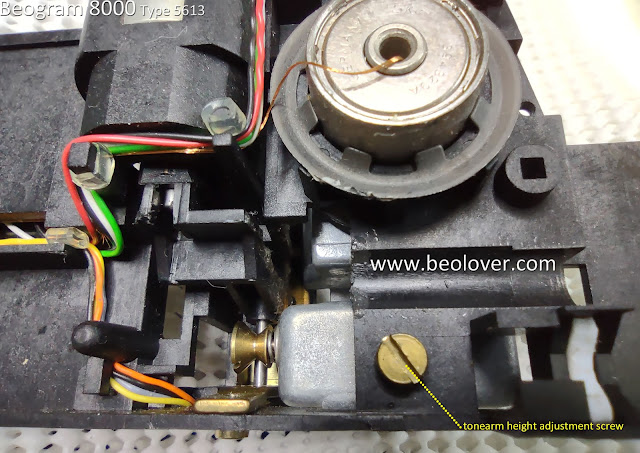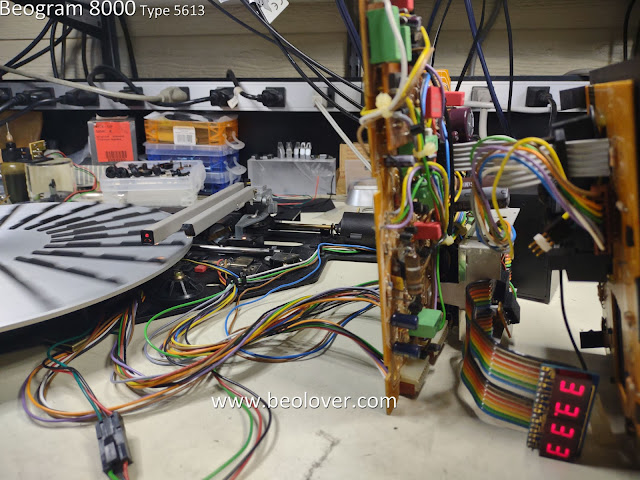With the Beogram 8000 circuit board restoration complete, it is time to get the floating chassis in shape to test them with. In the previous post I tested the restored PCBs with my Workshop Beogram 8000. My goal here was to be able to test the basic Beogram 8000 functions with all of its own components.
The Beogram 8000 floating chassis has a couple of electrolytic capacitors that needed replacing.
Both are for the +5 VDC power regulation circuit.
Here is the before photo.
Here is the after photo.
The floating chassis also has the phono muting relay circuit.
The muting relay often is still functional but after forty plus years of operation I go ahead and replace it.
Here is the original phono muting relay.
Most of the Beogram 8000 units I have seen have this National HB2-DC12V-H5 relay.
Unfortunately, it is no longer produced so my solution is to use Beolover's HB2 replacement for the Beogram 400x turntable, an Omron G6K-2F device mounted on a customer adapter board. That requires a little bit of modification though.
The Beogram 400x turntable relays operate at 24V instead of 12V which is required on the Beogram 8000. Luckily, the Omron G6K-2F relay comes in 12V as well as 24V. So that can easily be changed on the Beolover relay assembly.
One other modification to the Beolover replacement relay is to invert the PCB mounting posts. The position of the polarity on the Beogram 8000 circuit is mirrored to the normal mounting of the Beolover replacement relay device. Another easy modification though and here is the Beolover relay assembly re-configured for use in the Beogram 8000.
The last bit of restoration work that requires using a soldering gun is the modification I always make to the Beogram 8000 control panel.
The control panel needs to be opened up anyway to clean out dust.
It is pretty common to find a Beogram 8000 control panel with broken mounting tabs for the button PCB to the control panel buttons. This Beogram 8000 has a fully intact control panel.
For that reason I will show some photos of how to disassemble the control panel.
Here is the starting point...a fully intact Beogram 8000 control panel.
One small screw keeps the button circuit board in place on the control panel.
To disassembly the control panel, the small screw is removed, then the right edge of the board is raised slightly so the mounting hole clears the small mounting post the screw was attached to.
The button panel should be carefully slid to the right as the right edge is lifted.
Once the screw mounting post is cleared, the button circuit board will lift right off.
Here is the control panel disassembled for cleaning (and attaching my LDR test connector).
Here is the reassembled control panel with the test connector.
The test connector can be accessed for testing the control panel LDRs simply by opening the control panel by itself...while the rest of the Beogram 8000 is closed up.
The next steps in this restoration were to work on the platter hub (tachodisc replacement) and cleaning, adjusting the tangential arm assembly.
This Beogram 8000 looks like it still has a functioning tachodisc, but it is the original plastic (decal) kind and is already showing some signs of bubbling in the plastic decal. I replaced it with a new, metal tachodisc from Beoparts.
The tachodisc and its mounting ring need to fit tight, and they do.
You have to go slow and be patient to get the old tachodisc off and the new one properly installed where is fits perfectly flat.
On to the tangential arm assembly.
The Beogram 8000 service manual specifies that the top of the fixed arm (and tonearm) should be 23 mm from the top surface of the platter. That is similar to a Beogram 4002/4004 height adjustment.
However, while the platter height can actually be raised and lowered (a bit) on the Beogram 400x turntables, it cannot on a Beogram 800x turntable.
That means that the vertical tracking angle (VTA) on a Beogram 8000 is fixed. The arm height adjustment of 23 mm to the platter surface is purely cosmetic...but with B&O components, cosmetics are an important part. They must perform good and look good.
This arm height adjustment often takes several iterations when doing it with the tangential arm assembly fully assembled. With the spindle removed, it is easy to just slide the tangential arm assembly manually to make the height measurement between arm adjustments.
Here is the adjusted arm height.
Another reason to make these arm adjustments now is if the tonearm requires any height adjusting to align with the fixed arm.
The adjustment screw for the tonearm height is inconveniently located on the underside of the tangential arm assembly which makes it a real pain to adjust later...it means removing the arm assembly again for the adjustment. So now is the time to do it.
A common complaint of Beogram 8000 owners is that the Beogram starts dropping the arm onto a record instead of gently lowering it. Most of the time this is because the tonearm height adjustment screw touches the metal base of the tonearm (where the counter-weight is). For some reason the arm lowering mechanism slowly lowers (via the solenoid) but the arm itself delays and does not follow it.
Then, suddenly, the arm drops down as the screw releases from contact with the base of the tonearm.
It is not magnetic as the adjustment screw is brass. Nevertheless, I have witnessed this happening.
My solution is similar to what B&O does on the Beogram 400x tonearm lowering mechanism. I place a thin piece of plastic material (Dura-Lar) between the height adjustment screw and the base of the tonearm.
Moving on...Here are the tangential arm assembly main parts removed and cleaned.
For mounting the spindle back onto the floating chassis, I use some red grease for the two mounting ends.
For the two rails, I use some dry lubricant for the shiny, smooth rail surface.
For the spindle itself, I have plenty of the original lubricant mixture called out in the B&O service manual. That is Rocol MTS grease mixed with Esso NUTO oil.
I have mentioned this before, I use this mixture because I happen to have it. If I didn't have it, there are modern, synthetic oil substitutes that can be used. Just remember to not over do it when oiling the spindle.
The spindle spins so too much oil will result in oil being distributed all over the inside of the Beogram as the spindle turns.
Here is a photo of a test fitting of the cleaned tangential arm components prior to lubrication.
Reassembling the tangential arm spindle, spindle nut, bracket and rear rail can also test your patience a bit. I like to test fit it before doing it with oil applied.
Here is the tangential arm assembly reinstalled on the floating chassis.
I combined all of the components for this Beogram 8000 for a quick test of some basic functions (Play start, platter scanning, speed adjusting, return to Stop).
Everything I wanted to check worked.
Very nice to see. A major milestone in this restoration.
For the next post I will make the necessary service manual adjustments to prepare for record play and perform the first test play of a record.

















































